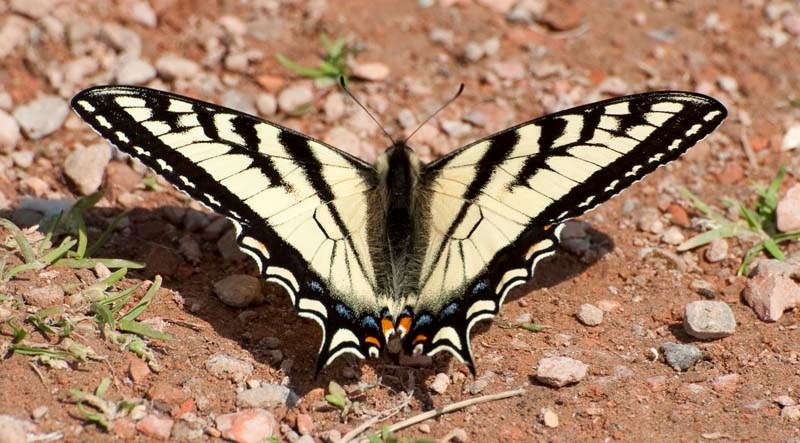Red means stop. So a few years ago when I saw something big and red crawling towards me on the sidewalk, I slammed the brakes on my bike and hopped off to take a look.
Red means stop. So a few years ago when I saw something big and red crawling towards me on the sidewalk, I slammed the brakes on my bike and hopped off to take a look.
Before me was a massive, segmented serpent the size of my thumb and the colour of old blood. It trundled inexorably forward, the angry eyebrows over its giant eyes showing its determination. Clearly, this was not a creature to be messed with.
So I messed with it. I redirected it with a lens-cap and took some pictures. It didn't seem to mind.
Later, I would learn that this creature was not a snake but a caterpillar of the tiger swallowtail – one of the biggest and most spectacular butterflies in this region.
Tiger swallowtails are huge butterflies known for their vibrant yellow wings with black, tiger-esque stripes on them. Their bodies are also striped, and often quite fuzzy.
Check their hind-wings (which are elongated like a swallow's), and you should also see some beautiful blue and orange scales. Entomologist John “The Nature Nut” Acorn says these scales likely act as fake eyes that distract predators – you'll often see big bites out of these wings as a result.
This is just about the peak of swallowtail season in Edmonton, says Julian Dupuis, a PhD student at the University of Alberta who studies butterflies. The peak should last a few more weeks before petering out at the end of June.
The tigers we see around here are Canadian tiger swallowtails, notes Royal Alberta Museum invertebrate zoologist Matthias Buck. There are also eastern, western and Appalachian variants, but those are separate species not found in Alberta.
There's a very slight chance that you might mistake an old world or anise swallowtail for a tiger, Dupuis says. Extremely rare around Edmonton, these butterflies have a big black blotch on their wings instead of black stripes.
Acorn says tiger swallowtails are usually seen fluttering along the edges of poplar forests or lilac bushes.
Most spend their time feeding on nectar from flowers – especially dandelions – or getting minerals from mud puddles, Dupuis says. You're unlikely to see any of their eggs, which are about a millimetre wide and green, as they're usually laid upon leaves 10 feet off the ground.
Cool caterpillars
Tiger swallowtail larvae have many adaptations meant to keep them safe from harm. You'll rarely see any of them, though, as they spend much of their lives feeding high up in trees, and do so mostly at night.
The caterpillars go through about five phases on the way to adulthood, Dupuis says.
They look like bird poop for their first three phases, having black heads and tails, hairy bodies and a big white spot in their middle.
During phases four and five, the swallowtail takes on a fearsome, snake-like appearance, with emerald, segmented skin, a small yellow stripe around its body, a big, bulbous “head” with two round eye spots, and a cute little “nose.” (The one I saw seemed to have eyebrows near its eyespots too.)
The eyespots are a disguise meant to make the caterpillar look like a small snake, Dupuis says – its actual head is the “nose” tucked underneath its fake head. The green colouration helps the caterpillar blend in with the green leaves it prefers to eat. “They're quite cool looking.”
When threatened, tiger swallowtails will rear back and shoot out two orange, foul-smelling glands called osmeteria from the back of their head that together look like a serpent's tongue, Acorn says.
“The whole caterpillar looks like a snake,” he notes, which is hopefully enough to spook a would-be predator.
Tiger swallowtail caterpillars turn red or brown when they're ready to pupate, reports the Royal Alberta Museum.
When they're ready, these caterpillars crawl down from their birth-trees and motor along to another protected spot such as a sheltered twig, Dupuis says. This move is likely an attempt to avoid predators attracted by the smell of the leaf damage inflicted on their home tree by their eating, he notes.
Once it finds a safe spot, the caterpillar suspends itself on a silk line and starts to transform. Its outer skin sloughs off, revealing the pupal form within which it will reorganize its organs in preparation for transformation.
That won't happen until next year, though.
“They spend the winter as a pupa,” Dupuis says, relying on antifreeze-like chemicals in their bodies to survive.
“They'll certainly survive the minus 40 temperatures we experience up here.”
The swallowtails we see fluttering around right now were laid as eggs last summer, in other words.
Tiger swallowtails typically emerge from their pupae around the May long weekend, Acorn says.
“They're an absolutely sure sign of the beginning of summer.”
Canadian tiger swallowtail
Name:
Papilio canadensis.
Appearance:
Big yellow butterfly with black stripes and blue/orange spots near its swallow-like tail. Caterpillars resemble small green or brown snakes, complete with eye-spots.
Commonly seen:
Fluttering lazily about the air near deciduous forests, or (as caterpillars) motoring along the sidewalk, looking like a snake.
Occasionally confused with:
Old World or anise swallowtails, which are smaller and have black blotches instead of stripes on their wings.
Fun fact:
The Canadian tiger swallowtail breeds just once a year, compared to the eastern tiger swallowtail, which breeds twice.
Wild St. Albert
Like wildlife? So do we! Every second Wednesday the Gazette profiles a reasonably common wild creature in the St. Albert region. Birds, beasts, bugs, fish … so long as it's alive and kicking, we'll feature it. <br /><br />Got a creature you'd like to see profiled? Send your suggestions to [email protected].




